
Fucus vesiculosus, known by the common names bladderwrack, black tang, rockweed, sea grapes, bladder fucus, sea oak, cut weed, dyers fucus, red fucus and rock wrack, is a seaweed found on the coasts of the North Sea, the western Baltic Sea and the Atlantic and Pacific Oceans. It was the original source of iodine, discovered in 1811, and was used extensively to treat goitre, a swelling of the thyroid gland related to iodine deficiency.

Fucus is a genus of brown algae found in the intertidal zones of rocky seashores almost throughout the world.

Palmaria palmata, also called dulse, dillisk or dilsk, red dulse, sea lettuce flakes, or creathnach, is a red alga (Rhodophyta) previously referred to as Rhodymenia palmata. It grows on the northern coasts of the Atlantic and Pacific Oceans. It is a well-known snack food. In Iceland, where it is known as söl, it has been an important source of dietary fiber throughout the centuries.
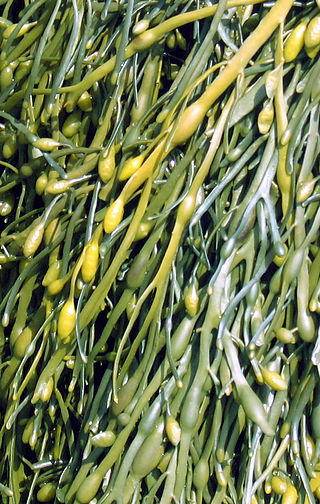
Ascophyllum nodosum is a large, common cold water seaweed or brown alga (Phaeophyceae) in the family Fucaceae. A. nodosum is also known in localities as feamainn bhuí, rockweed, Norwegian kelp, knotted kelp, knotted wrack or egg wrack. It is a seaweed that dominates the intertidal zone and grows only in the northern Atlantic Ocean, along the north-western coast of Europe including east Greenland and the north-eastern coast of North America, its range further south of these latitudes being limited by warmer ocean waters. Ascophyllum nodosum has been used numerous times in scientific research and has even been found to benefit humans through consumption.

Ulva lactuca, also known by the common name sea lettuce, is an edible green alga in the family Ulvaceae. It is the type species of the genus Ulva. A synonym is U. fenestrata, referring to its "windowed" or "holed" appearance.

Ceramium is a genus of Ceramium algae. It is a large genus with at least 15 species in the British Isles.

Atractophora hypnoides is a rare red alga (Rhodophyta) found in the British Isles, France and some Atlantic Islands and is the only species of the genus found in the British Isles. It is attached to the rock or other algae by a small basal disc and is much branched with downgrowing filaments which enclose the main branch or axis forming a cortex. Short filaments of limited growth radiate in whorls from the axis and frequently convert into hairs. The spreading filaments grow irregularly in a diffuse manner. Microscope examination is required for identification.
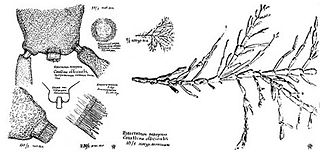
Corallina officinalis is a calcareous red seaweed which grows in the lower and mid-littoral zones on rocky shores.
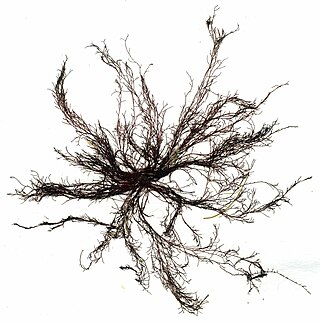
Polysiphonia is a genus of filamentous red algae with about 19 species on the coasts of the British Isles and about 200 species worldwide, including Crete in Greece, Antarctica and Greenland. Its members are known by a number of common names. It is in the order Ceramiales and family Rhodomelaceae.

Libocedrus plumosa, with the common name kawaka, is a species of Libocedrus that is endemic to New Zealand.

Bryopsis is a genus of marine green algae in the family Bryopsidaceae. It is frequently a pest in aquariums, where it is commonly referred to as hair algae.
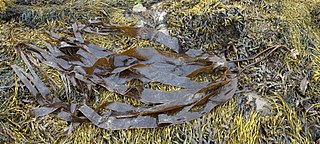
Laminaria digitata is a large brown alga in the family Laminariaceae, also known by the common name oarweed. It is found in the sublittoral zone of the northern Atlantic Ocean.

Ulva intestinalis is a green alga in the family Ulvaceae, known by the common names sea lettuce, green bait weed, gutweed, and grass kelp. Until they were reclassified by genetic work completed in the early 2000s, the tubular members of the sea lettuce genus Ulva were placed in the genus Enteromorpha.

Codium fragile, known commonly as green sea fingers, dead man's fingers, felty fingers, forked felt-alga, stag seaweed, sponge seaweed, green sponge, green fleece, sea staghorn, and oyster thief, is a species of seaweed in the family Codiaceae. It originates in the Pacific Ocean near Japan and has become an invasive species on the coasts of the Northern Atlantic Ocean.
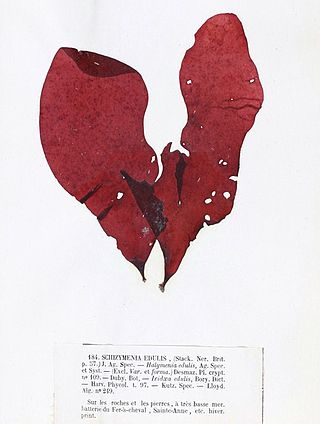
Dilsea carnosa, commonly known as the poor man's weather glass or the sea belt, is a species of red algae in the Dumontiaceae family of the order Gigartinales.

Polysiphonia stricta is a small red marine alga in the Division Rhodophyta.

Prasiola crispa is a small terrestrial green alga. It has been recorded world-wide mostly from cold-temperate to polar regions.
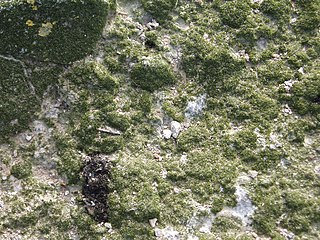
Prasiola stipitata is a small green alga.
Cladostephus hirsutus is a marine brown alga.

















